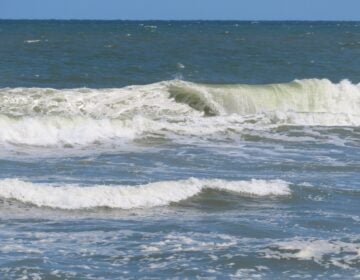Around the world in books and a box
This is part of a series from Ilene Dube of The Artful Blogger.
In the 1950s, when Ray Bradbury wrote Fahrenheit 451, the idea of desecrating a book was sacrilege. No dog earing the pages, we were taught; no scribbling.
But books aren’t what they used to be.
Artists paint over pages and paste in collage to create altered books; poets have invented a form based on randomized words cut from bound volumes picked up at rummage sales; and marginalia has become its own literary form. Even architects create dwellings from the carcasses of former knowledge, and libraries and universities use offsite morgues to store their quaint and curious volumes of forgotten lore.
As an undergraduate, sculptor Tom Bendtsen faced a mountain he could never climb — all those books he was expected to read as a western male artist.
“I was interested in how we remember and store information in our heads, little bits of neurons that lead to thoughts,” he says. “Books inform our brains, we put them together to form ideas. Exposure to politics, history and literature enables us to become who we are. So I configured the books I should have read and created this mass of knowledge.”
His rectangular structure of 6,000 books, 8 feet tall, with a staircase ascending its stacks, can be seen in World Sampler, a group sculpture show at Artworks Trenton through Feb. 23.
Bendtsen’s book sculpture took about 50 hours to install. “I don’t slave in the studio,” he says. “It’s where I draw and plan, but the work is done on site.”
Many of Bendtsen’s book sculptures are titled “Arguments” followed by a number. The one at Artworks is titled “Conversation #5.”
“We are all influenced by, and have access to, the same information,” says Bendtsen. “And yet we’re able to construct vastly different ideas and arguments.”
Knowledge gleaned from books can be used to construe whatever you want, he says. “People tend to believe that more information makes you smarter and the more information you have, the better decisions you’ll be able to make.”
But having greater access to information doesn’t make us any better informed, nor does the volume of information available bring us any closer to solving the world’s problems.
The books are grouped by color – Bendtsen compares the blue, yellow or black spines to pixels. “Mysteries are often black, for some reason,” he says.
The empty spaces between the books become stages — small scenes with miners are hidden in the gaps on the dark side of the work, with coal made of burned wood.
Mushrooms fill the gaps on the sunny side — he gathered the dried fungus from Korean mushroom soup. “They are relatives of the mold and mildew found in old books.”
Bendtsen often gets reactions from viewers to the tune of “aren’t there better uses for books?” The answer is “no.” Bendtsen, who acknowledges his generation may be the last to read books in this form, has rescued these from recycling centers.
While using building blocks made up of words and thoughts, Bendtsen doesn’t get distracted. “I don’t have time to read them – I see the graphic quality of the spines but don’t open them.”
“Tom is a deep thinker,” says World Sampler curator Heinrich. “I read an interview with him in which he spoke of a Hegelian view of society that has reached a peak of functionality and decline. I had to look up Hegel.”
Heinrich’s own work, “Rhetorical Progress,” is a universe of its own, with globes and planets and worlds dripping from the sky and pooled at ground level. Her statement says it “examines negative underlying issues of world development and technology; dwindling global resources and the fragility of world ecology.”
Camouflage netting at the base surrounds endangered wildlife, crying babies, military conflict, materialism. A turntable goes round and round with a yin and yang of camouflage patterns. There are orbs encrusted with coral, jewels, and pearls to represent the riches taken from the earth, to one covered with photo transfers of Hitler and Sadam Hussein.
The title piece, “World Sampler,” was inspired by a Whitman’s Sampler box, but instead of cherry cordials and caramel cashew clusters, Heinrich’s oversized candy box contains an assortment of faces from around the world, lips painted with flags of Qatar, Brazil and Germany; Lady Gaga, “The Scream,” skulls, a nautilus and a baby yawning. “A world sampler can have a little of everything,” says Heinrich.
How does Heinrich think up all these things? “I can’t stop thinking about them,” she says.
World Sampler also contains artwork by Carl Gombert, Eve Ingalls, Benjamin Jones, Monica Kane, Alan Kesselhaut, and George Shortess, and is on view at Artworks, 19 Everett Alley, Trenton, through Feb. 23. Gallery hours: Tuesday 11 a.m.-7 p.m., Thursday 2-7 p.m., Saturday 10 a.m.-4 p.m. http://artworkstrenton.org
______________________________________________________________
The Artful Blogger is written by Ilene Dube and offers a look inside the art world of the greater Princeton area. Ilene Dube is an award-winning arts writer and editor, as well as an artist, curator and activist for the arts.
WHYY is your source for fact-based, in-depth journalism and information. As a nonprofit organization, we rely on financial support from readers like you. Please give today.




